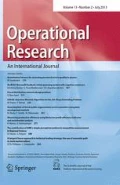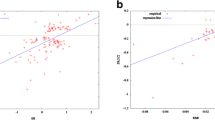Abstract
Calendar anomalies (CAs) have been puzzling financial economists and practitioners for decades. The existence of CAs violates one of the most significant financial theories: the efficient market hypothesis (Fama in J Finance 25:383–417, 1970). Up to date most financial economists have examined the existence of CAs only in capital markets. However, as most scholars suggest, an economy’s financial structure includes two main distribution channels: financial markets and financial intermediaries. Therefore, a question that emerges is why do we examine the CAs only in financial markets? Banks are the most important amongst the financial intermediaries; therefore in this study we try to implement the CAs approach to banking. We present the theoretical framework and analytically explain how we apply this approach to banking. In order to examine whether CAs exist we implemented this newly suggested approach in the Greek time deposits market during the period 2003–2013 and we provided empirical evidence for a month effect pattern. The CAs existence: (1) is an indication of market inefficiency, (2) it could be an indirect way to conclude the window dressing (WD) implementation, which is a way to increase the bank opacity, (3) documents a new calendar effect, and (4) may suggest a new approach to the banking efficiency study. Moreover, CAs could be linked to bankers’ WD behavior, “forcing” them to increase the new offered bank premiums at the quarters’ end, in order to attract more deposits.



Similar content being viewed by others
Notes
At this point it is worth mentioning that another practical way to examine the EMH for the capital markets is by examining the trading rules’ profitability (Brown and Jennings 1989). If trading rules prove to be profitable this means that past patterns benefit investors to over-perform the market. However, in this study we focus on the calendar patterns which are more suitable for the available data as we present below.
At this point it is worth mentioning that we have tried to collect, at least on a monthly basis, data from each Financial Institution. However, these data were extremely confidential and The Bank of Greece was not forthcoming. Therefore, similarly to most CAs studies we do not use the individual data (each stock separately), but the consolidated (index examination).
Source: ECB Statistical Data Warehouse. Short description Greece, Annualised agreed rate (AAR)/Narrowly defined effective rate (NDER), Credit and other institutions (MFI except MMFs and central banks) reporting sector—deposits with agreed maturity, up to 1 year original maturity, up to 1 year, New business coverage, Non-Financial corporations and Households (S.11 and S.14 and S.15) sector, Euro. The code name is MIR: MIR.M.GR.B.L22.F.R.A.2230.EUR.N).
Demirgüç-Kunt and Levine (2001) categorize Greece in the bank-based economies. Moreover, by examining the specific issue following their approach we reach similar conclusions, but the analysis of the specific issue is beyond this paper’s scope. For a more detailed analysis regarding the financial sector’s structure, the benefits of the bank-based and the market-based financial systems see also Levine (2002), and Beck et al. (2000).
For the Greek financial markets’ efficiency there is vast literature (Vasileiou and Samitas 2015 review some of the most important among them) which examines the stock market’s efficiency using the calendar anomalies approach, but there is no study for calendar anomalies in banking.
In contrast to the previous period 2003–2010, banks could not sell the deposits at increased rates, so the BP were negative because the only lender in the Greek banking system since then has been the Greek state via T-bills.
If a time series is not stationary we have to turn it to stationary otherwise the results will not be accurate. For example, for a stationary series, ‘shocks’ to the system will gradually die away, but in a non-stationary time series will influence all the latter results (Brooks 2008).
Here we refer to the mean BP’s value, not to its statistical significance.
In the “Appendix” we present detailed information for the model’s selection process.
Before the Greek request for entrance to the ESM.
This “rule’s” exception is the statistically significant bank premiums growth that takes place in October.
At this point it is worth mentioning that we examined the deposits influence in the BPC, but the results were similar to those with the crisis dummy.
References
Akaike H (1974) A new look at the statistical model identification. IEEE Trans Autom Control 19:716–723
Alexakis P, Xanthakis M (1995) Day of the week effect on the Greek stock market. Appl Financ Econ 5(1):43–50
Allen L, Saunders A (1992) Bank window dressing: theory and evidence. J Bank Finance 16(3):585–623
Allen F, Chui M, Maddaloni A (2004) Financial systems in Europe, the USA and Asia. Oxford Rev Econ Policy 29(4):490–508
Beck T, Demirgüç-Kunt A, Levine R (2000) A new database on the structure and development of the financial sector. World Bank Econ Rev 14(3):597–605
Boot Α, Thakor Α (1997) Financial system architecture. Rev Financ Stud 10(3):693–733
Brooks C (2008) Introductory econometrics for finance. Cambridge University Press, Cambridge
Brooks C, Burke SP (2003) Information criteria for GARCH model selection. Eur J Finance 9:557–580
Brown DP, Jennings RH (1989) On technical analysis. Rev Financ Stud 2(4):527–551
Chan K, Gup B, Pan M (1992) An empirical analysis of stock prices in major Asian markets and the United States. Financ Rev 27(2):289–307
Demirgüç-Kunt A, Huizinga H (2004) Market discipline and deposit insurance. J Monet Econ 51(2):375–399
Demirgüç-Kunt A, Levine R (2001) Bank-based and market-based financial systems: cross-country comparisons. In: Demirgüç-Kunt A, Levine R (eds) Financial structure and economic growth: a cross-country comparison of banks, markets, and development. MIT Press, Cambridge, pp 81–140
Fama E (1970) Efficient capital markets: a review of theory and empirical work. J Finance 25:383–417
Fama E, Fisher L, Jensen M, Roll R (1969) The adjustment of stock prices to new information. Int Econ Rev 10(1):1–21
Flannery M, Kwan S, Nimalendran M (2013) The 2007–2009 financial crisis and the bank opaqueness. J Financ Intermed 22(1):55–84
Gorton G (2009) Information, liquidity, and the (ongoing) panic of 2007. Am Econ Rev 99(2):567–572
Levine R (2002) Bank-based or market-based financial systems: Which is better? J Financ Intermed 11(4):398–428
Levine R, Zervos S (1998) Stock markets, banks and economic growth. Am Econ Rev 88(3):537–558
Lintner J (1965) Security prices, risk, and maximal gains from diversification. J Finance 20(4):587–615
Mishkin F, Eakins S (2012) Financial markets and institutions, 7th edn. Rearson Education Limited, England
Schwarz G (1978) Estimating the dimension of a model. Ann Stat 6:461–464
Schwert GW (2003) Anomalies and market efficiency. In: Constantinides G et al (eds) Handbook of the economics of finance, Chap. 17. North Holland, Amsterdam
Sharpe WF (1964) Capital asset prices: a theory of market equilibrium under conditions of risk. J Finance 19:425–442
Vasileiou E (2014) Political stability and financial crisis: what the data say for the European Union’s Countries. Int J Res Bus Soc Sci 3(1):143–169
Vasileiou E (2015) Re-examination of the banking window dressing theory: new methodological approaches and empirical evidence from the Greek case. J Financ Regul Compliance 23(3):252–270
Vasileiou E, Samitas A (2015) Does the financial crisis influence the month and the trading month effects? Evidence from the Athens Stock Exchange. Stud Econ Finance 32(2):181–203
Author information
Authors and Affiliations
Corresponding author
Ethics declarations
Conflict of interest
The authors declare that they have no conflict of interest.
Informed consent
Why do we examine calendar anomalies only in financial markets? Month Effect evidence from the Greek banking industry.
Appendix
Appendix
As we mention in the respective section we use the GARCH modeling in order to resolve autocorrelation and ARCH LM issues that emerge when the OLS estimation process is applied. We examined several GARCH family models, namely simple GARCH, MGARCH, EGARCH and TGARCH in order to find which better fits our sample and our scope of study. The autocorrelation and ARCH LM issues have been resolved, and for the simplest lag order the AIC and SIC criteria suggest that simple GARCH model better fits our data sample (Table 5). We present the results if we use the mean Eq. (3). The results are similar when the mean Eqs. (5) or (6) is applied.
The next step in the selection process was to find the optimal lag order. We used three mean equation versions, for which the lag order is not the same. However, even if the lag order changes the AIC and SIC estimations, the economic results do not change the coefficient signs and the statistical significance are pretty stable. Therefore we choose to present the simple GARCH (1, 1) model in order not to confuse the reader with several lag-ordered models adding no important information to our study’s scope.
Rights and permissions
About this article
Cite this article
Evangelos, V. Why do we examine calendar anomalies only in financial markets? Month effect evidence from the Greek banking industry. Oper Res Int J 17, 99–114 (2017). https://doi.org/10.1007/s12351-015-0217-6
Received:
Revised:
Accepted:
Published:
Issue Date:
DOI: https://doi.org/10.1007/s12351-015-0217-6




